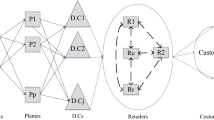Abstract
This paper describes the work that led to the realisation of an extended graph-based virtual clustering-enhanced approach to supply chain optimisation. The Supply-Chain Operations Reference (SCOR) model defined by the Supply-Chain Council in Pittsburgh, PA, USA is used to denote a typical supply chain, which may include geographically distributed suppliers, warehouses, factories, distribution centres (DCs), transportation and customers. A graph representation is proposed to represent and analyse the business processes of the SCOR model from customer orders to suppliers. Furthermore, logical relationships are superimposed onto the graph. This extended graph enables the complex relationships between the nodes of two adjoining layers to be described. By so doing, it is able to model a complex supply chain with multiple level assembly, various types of transportations and a multiple split and merge of orders. In order to handle a large-scale supply chain optimisation problem, the extended graph is enhanced by virtual clustering so as to realise an approach that is able to downscale the optimisation problem and reduce the search space. A case study is used to illustrate the effectiveness of the proposed approach. The details of the SCOR model, the extended graph, the virtual clustering, the proposed approach and the case study are presented in this paper.
















Similar content being viewed by others
References
Luo Y, Zhou M, Caudill RJ (2001) An integrated e-supply chain model for agile and environmentally conscious manufacturing. IEEE/ASME Trans Mechatron 6(4):377–386
Dong M, Chen FF (2001) Process modelling and analysis of manufacturing supply chain networks using object-oriented petri nets. Robot Comput Integ Manufact 17:121–129
Lakhal S, Martel A, Kettani O, Oral M (2001) Theory and methodology on the optimisation of supply chain networking decisions. Europ J Oper Res 129(2):259–270
Ettl M, Feigin GE, Lin GY, Yao DD (2000) A supply network model with base-stock control and service requirements. Oper Res 48(2):216–232
Rao U, Scheller-Wolf A, Tayur S (2000) Development of a rapid-response supply chain at Caterpillar. Oper Res 48(2):189–204
Ruppand TM, Ristic M (2000) Fine planning for supply chains in semiconductor manufacture. J Mater Process Technol 107(1–3):390–397
Lendermann P, Gan BP, McGinnis LF (2001) Distributed simulation with incorporated APS procedures for high-fidelity supply optimisation. In: Proceedings of the 2001 Winter Simulation Conference, Arlington, VA, 9–12 December 2001
Parsons DJ, Phelps RA (2001) Production scheduling validity in high level supply chain models. In: Proceedings of the 2001 Winter Simulation Conference, Arlington, VA, 9–12 December 2001
Dumond Y, Roche C (2000) Formal specification of a multi-agent system architecture for manufacture: the contribution of the pa-calculus. J Mater Process Technol 107:209–215
Raghavan NRS, Viswanadham N (1999) Performance analysis of supply chain networks using petri nets. In: Proceedings of the 38th Conference on Decision & Control, Phoenix, AZ, 9–12 December 1999
Ito T, Salleh MR (2000) A blackboard-based negotiation for collaborative supply chain system. J Mater Process Technol 107:98–103
Archibald A, Karabakal N, Karlsson P (1999) Supply chain vs supply chain: using simulation to compete beyond the four walls. In: Proceedings of the 1999 Winter Simulation Conference, Arlington, VA, 9–12 December 2001
Padmos J, Hubbare B, Duczmal T, Saidi S (1999) How i2 integrates simulation in supply chain optimisation. In: Proceedings of the 1999 Winter Simulation Conference, Arlington, VA, 9–12 December 2001
Supply-Chain Council (2002) Supply-chain operations reference-model: an overview of SCOR version 5.0.http://www.supply-chain.org/slides/SCOR5.0OverviewBooklet.pdf. Cited 1 April 2002
Evans JR, Minieka E (1992) Optimisation algorithms for networks and graphs. Marcel Dekker, New York
Offodile OF, Mehrez A, Grznar J (1994) Cellular manufacturing: a taxonomic review framework. J Manufact Sys 13(3):196–220
Chen WH, Srivastava B (1994) Simulated annealing procedures for forming machine cells in group technology. Europ J Oper Res 75(1):100–111
Author information
Authors and Affiliations
Corresponding author
Rights and permissions
About this article
Cite this article
Khoo, L.P., Yin, X.F. An extended graph-based virtual clustering-enhanced approach to supply chain optimisation. Int J Adv Manuf Technol 22, 836–847 (2003). https://doi.org/10.1007/s00170-003-1605-2
Received:
Accepted:
Published:
Issue Date:
DOI: https://doi.org/10.1007/s00170-003-1605-2




